SQL Server has table, where one record is FK to the same table (parent record or 'null' if it's first record):
CREATE TABLE [dbo].[RegisteredDevice]
(
[Id] [int] IDENTITY(1,1) NOT NULL,
[PreviousDeviceId] [int] NULL,
[Position] [int] NULL,
[DeviceName] [nvarchar](max) NOT NULL,
[ModelNumber] [nvarchar](max) NOT NULL,
CONSTRAINT [PK_RegisteredDevice]
PRIMARY KEY CLUSTERED ([Id] ASC)
WITH (PAD_INDEX = OFF, STATISTICS_NORECOMPUTE = OFF,
IGNORE_DUP_KEY = OFF, ALLOW_ROW_LOCKS = ON,
ALLOW_PAGE_LOCKS = ON, OPTIMIZE_FOR_SEQUENTIAL_KEY = OFF) ON [PRIMARY]
) ON [PRIMARY] TEXTIMAGE_ON [PRIMARY]
GO
ALTER TABLE [dbo].[RegisteredDevice] WITH CHECK
ADD CONSTRAINT [FK_RegisteredDevice_RegisteredDevice_PreviousDeviceId]
FOREIGN KEY([PreviousDeviceId])
REFERENCES [dbo].[RegisteredDevice] ([Id])
GO
ALTER TABLE [dbo].[RegisteredDevice]
CHECK CONSTRAINT [FK_RegisteredDevice_RegisteredDevice_PreviousDeviceId]
GO
I have the following SQL code:
BEGIN TRANSACTION
UPDATE [RegisteredDevice]
SET [PreviousDeviceId] = 2
WHERE [Id] = 5;
UPDATE [RegisteredDevice]
SET [PreviousDeviceId] = 4
WHERE [Id] = 2;
UPDATE [RegisteredDevice]
SET [PreviousDeviceId] = 1
WHERE [Id] = 3;
COMMIT TRANSACTION
For this data:
but this code is not executed inside transaction:
Msg 2601, Level 14, State 1, Line 4
Cannot insert duplicate key row in object 'dbo.RegisteredDevice' with unique index 'IX_RegisteredDevice_PreviousDeviceId'. The duplicate key value is (2).
The statement has been terminated.Msg 2601, Level 14, State 1, Line 6
Cannot insert duplicate key row in object 'dbo.RegisteredDevice' with unique index 'IX_RegisteredDevice_PreviousDeviceId'. The duplicate key value is (4).
The statement has been terminated.Msg 2601, Level 14, State 1, Line 8
Cannot insert duplicate key row in object 'dbo.RegisteredDevice' with unique index 'IX_RegisteredDevice_PreviousDeviceId'. The duplicate key value is (1).
The statement has been terminated.
If all these changes will be committed inside one transaction, there is no any duplicate key. Why transaction is not processed?
